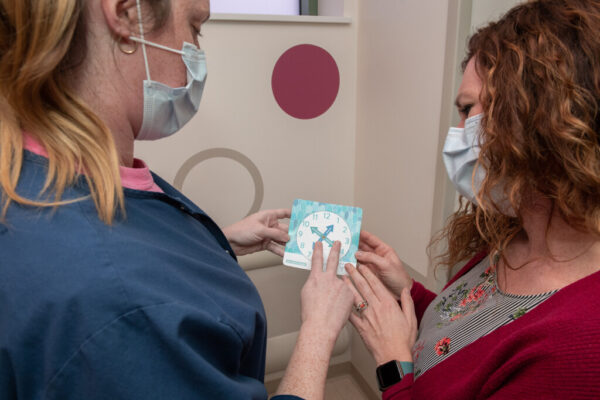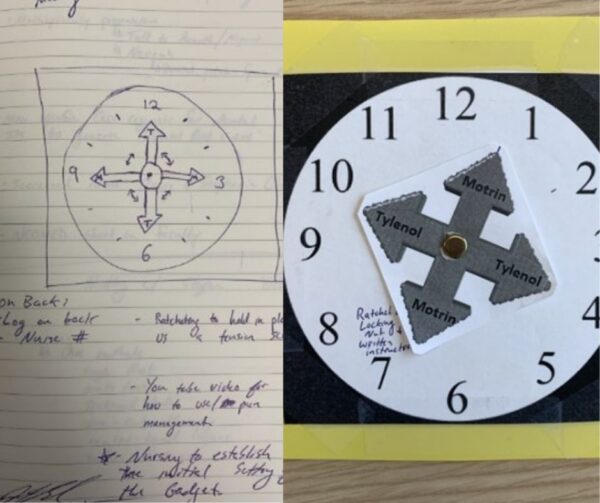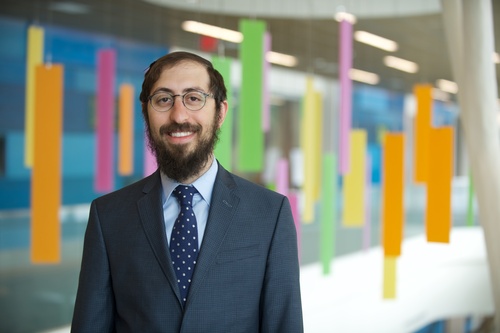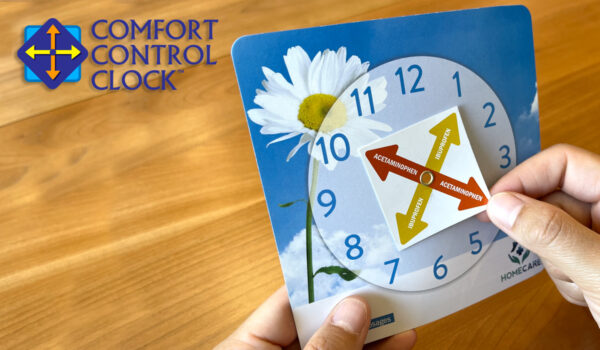
The Comfort Control Clock, created by pediatric dentist Dr. Jeff Berlin, helps patients with medication reminders.
While sitting in a meeting of the Surgical Value Optimization Committee, pediatric dentist Dr. Jeff Berlin began doodling in his notebook. But this wasn’t just your average doodling to pass the time.
“The committee was working on a universal surgical quality project around reducing opioid prescribing post surgeries,” he said. “We talked about creating order sets in the EMR to prescribe alternating Tylenol and Motrin every 3 hours.”
A growing number of clinicians recommend this practice to achieve optimal pain control without the use of opioids. Although this approach offers substantial benefits, some people have trouble remembering which medication they took most recently – creating the risk of taking the same medication twice. Research shows careful time tracking not only prevents overdoses, but it also maximizes analgesia, which in turn minimizes the need for narcotics.
Dr. Berlin sketched out a simple clock with hands that pointed to the 12, 3, 6 and 9 with either Tylenol or Motrin on the clock hand to show when a person should take which medication.

Dr. Berlin’s original sketch from his “idea” notebook and his mockup he made with his kids’ arts and crafts supplies.
“The arrows would be free to spin about a central rivet so that the hands can be adjusted to point to different times, but the arrows remain fixed 90 degrees apart and therefore when one is moved, they all move and point to the correct dosing times regardless of where the first dose arrow was pointed,” said Dr. Berlin
Using his kids’ arts and crafts supplies, he made the first physical prototype. Although he wasn’t sure if his simple invention would spark any interest, he took his idea to Stefan Agamanolis, chief innovation officer, and his team in Akron Children’s Innovation Center. That initial meeting with Stefan and his staff happened in April 2019 and their interest was piqued.
“When we look at inventions, we take a 3-pronged approach,” said Stefan. “We look for desirability (is there a need), feasibility (is this something we can build and test for its intended effect) and viability (is this something a successful business can be built around).”
Erica Whalen, innovation project coordinator, took on the task of manufacturing the clocks in house with a rivet machine to test them out in places like the outpatient surgery center, the Heart Center, urgent care and the emergency departments.
“When I dropped the clocks off, the providers were excited,” said Erica. “Nurses used them at the bedside for patient education on pain control and then parents could take them home and hang them on the fridge as a medication tracking tool.”

Dr. Jeff Berlin
The Innovation Center, working together with Quality Services, conducted parent and staff surveys to gather impressions on the benefits of the device.
“The surveys helped us get a sense of the value proposition,” said Stefan. “In addition to patient families finding them helpful for choosing the right medication at a given time, we found that staff members felt it made the education process better and faster.”
The team filed a patent application and continued refining the design while also searching for a company that could manufacture and sell the product.
“We found a great northeast Ohio-based partner that could help us bring Dr. Berlin’s invention to market,” said Stefan. “Hospitals and providers can order the clocks and customize them with their own colors, logos, address and phone numbers.”
In July 2022, the patent was issued, providing additional recognition of the novelty and usefulness of the device. Dr. Berlin says although his idea was simple, commercializing an invention can still take years. But, he says, that shouldn’t prevent people from pursuing their ideas.
“This was a big opportunity for me to learn how the innovation world works,” he said. “I had to keep plugging away at my idea. We tinkered with the design. I learned to enjoy the process and not obsess over the finish line because that can wear you down.”

The Comfort Control Clock has been patented and commercialized. Providers and health care organizations can personalize the clock with their logo and branding when ordering them.
Stefan hopes Dr. Berlin’s success will inspire other Akron Children’s inventors to come forward with their ideas.
“I often talk about how creative our workforce is, and I know there are more ideas and inventors out there just waiting to be discovered,” says Stefan.
For those prospective inventors, Dr. Berlin suggests keeping a notebook on your desk or in your briefcase to jot down creative ideas, even if they aren’t fully formed.
“It helps to put it on paper and take it to the Innovation team,” said Dr. Berlin. “They may tell you it’s not quite there yet or they may help you polish it up so it can be pursued. Either way, you won’t know until you try.”
“The Comfort Control Clock is an example of an invention that completed its full journey from initial disclosure, further refinement and development, protection of intellectual property, and licensing to a manufacturing partner to bring to market,” said Stefan. “It’s a success story we are very proud of, and we hope it inspires other inventors.”
For information on ordering the Comfort Control Clock, visit this website.










